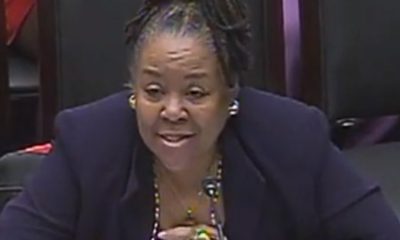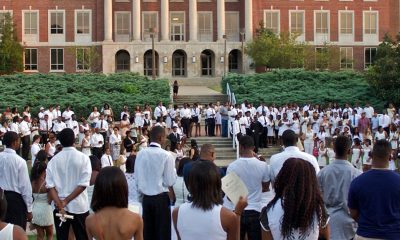Black History
College of Charleston African American Studies Professor Explains History of Juneteenth
CHARLESTON CHRONICLE — The United States of America is known for its annual celebration of freedom from the British Empire every year on the Fourth of July, a time when the stars and stripes of the American flag abound and fireworks light up the night sky. But there is another, lesser known, but equally significant, celebration of American independence that takes place ahead of the pomp and circumstance of July 4. Juneteenth is an annual celebration on June 19th that marks the date in 1865 when word reached Texas, more than two years after the Emancipation Proclamation, that slavery had been abolished and those enslaved were free.
By The Charleston Chronicle
The United States of America is known for its annual celebration of freedom from the British Empire every year on the Fourth of July, a time when the stars and stripes of the American flag abound and fireworks light up the night sky.
But there is another, lesser known, but equally significant, celebration of American independence that takes place ahead of the pomp and circumstance of July 4. Juneteenth is an annual celebration on June 19th that marks the date in 1865 when word reached Texas, more than two years after the Emancipation Proclamation, that slavery had been abolished and those enslaved were free.
In the more than 150 years since this seminal moment in American history, African-American communities have marked the occasion of Juneteenth with picnics, festivals and church services.
Anthony Greene, Associate Professor of African American Studies and sociology, says Juneteenth celebrations are uplifting, but that the annual holiday carries the weight of history within its cultural significance.
“Although it marks a day of family, food, and fun, it’s also critically important that Juneteenth is a tribute to the legacy and power of a people who endured and overcame the most unimaginable conditions,” says Greene.
Here are five questions to Greene about the history of Juneteenth, the significance of the annual celebration, and why it’s important to recognize Juneteenth within the larger context of American culture.
What are the historical origins of Juneteenth?
As America prepares to celebrate its independence, many African Americans conjure up a little known, and often omitted, significant fact during this time – upon gaining its independence, black people remained enslaved (see Frederick Douglass’s essay What Does the 4th of July Mean to Negroes). As such, independence, as it is celebrated, has two distinct historical meanings.
To commemorate when enslavement was abolished, Americans inaccurately highlight the Emancipation Proclamation signed by Abraham Lincoln, which took effect on Jan. 1, 1863. However, Lincoln’s proclamation was issued only to Confederate states in areas that were liberated by the Union Army. It was not for the intent and purpose to abolish slavery as an institution. Slavery remained legal until 1865 when the 13th Amendment abolished slavery and “involuntary servitude.”
Despite its abolishment, the 250,000 enslaved Africans in Texas did not immediately learn of their freedom. Several accounts have been put forth to explain why there was a two-and-a-half-year delay in the news of emancipation to Slaves in the Lone Star State:
· A messenger was murdered on his way to Texas with the news of freedom.
· The news was purposely withheld by slave masters to maintain a labor force.
· Slave owners wanted to generate one last cotton harvest.
The announcement of freedom to the enslaved population in Texas has become known as Juneteenth (also known as the Black 4th of July). It is the oldest known celebration commemorating the ending of slavery in the United States. This African-American holiday observes June 19, 1865, as the official day of independence and freedom for blacks in America. It is noted that June 19th is not the exact day blacks were freed, rather it’s the day they were told they were free.
Traditionally, how has Juneteenth been observed within African-American communities?
Early Juneteenth celebrations were marred by outward resistance among many southern whites. As Jim Crow laws started to emerge, black communities were unable to use public venues, such as parks, for celebrations, thus turning to church grounds and rural areas, often near rivers and creeks for activities such as fishing.
Festivities would include barbecues, fishing and horseback riding. As blacks became landowners, land often would be donated for Juneteenth celebrations. In the early decades of the celebration, Juneteenth flourished. Across the state of Texas, and in the south overall, Juneteenth celebrations became a boastful annual tradition.
Has the cultural awareness of Juneteenth changed in recent decades? Why?
In the early 20th century, there was a small decline in its celebration in large part due to how formal educational curriculums put emphasis on President Lincoln’s Emancipation Proclamation as the sole act to abolish slavery. Little to no formal acknowledgment of June 19th and its historical significance was taught in schools. Although celebrations did not completely cease, the large-scale celebrations did begin to decline.
Not until the civil rights and black power movements of the 1960s and early 1970s was there a resurgence of Juneteenth. The black power movement, in particular, with its emphasis on pride, culture, identity, and re-claiming history, helped spark a renewed interest in Juneteenth. Additionally, as Black Studies (African American Studies) programs have developed on college campuses, accurate black historical narratives have emerged, also helping to generate more interest in celebrations such as Juneteenth.
How is Juneteenth celebrated today?
Today, Juneteenth is observed by communities around the country. People celebrate black culture, commemorate black history, and uplift and honor the black freedom struggle.
With its significant place in the annals of black history, Charleston is a noteworthy locale for its Juneteenth (and Memorial Day) celebrations. Just three years ago, four days before Charleston’s Juneteenth holiday, Dylann Roof took the lives of nine members of Emanuel A.M.E. Church, home of the freedom fighter Denmark Vesey. The remembrances of those lives lost, the legacy of enslavement, the contributions of all those who fought to improve the lived experiences of Black Charlestonians would embody the 2015 Juneteenth celebration.
Why is it important to continue to recognize and observe the Juneteenth holiday?
American society has a unique, often detached, relationship regarding African-American holidays and observances. From Black History Month to Kwanzaa to Juneteenth, some Americans routinely question the “need” for these specialized celebrations. This questioning does not exist when Americans collectively embrace St. Patrick’s Day or Cinco de Mayo. Juneteenth is American history, a history that happens to reflect the cultural and historical existence of African-Americans. Outside of the holiday for Martin Luther King, Jr., American society does not collectively acknowledge Juneteenth as a critical moment in American history, despite in 2014 President Barack Obama declaring June 19th as a National Day of Observance.
American history continues to present the single-story narrative which often highlights and embraces dominant group culture. It has never recognized, embraced, nor honored the histories and culture of racialized minority groups. Consequently, these groups ( African- Americans, Native-Americans, Hispanics, Asians) have fought for their histories and cultures to be acknowledged and appreciated. For America to truly be inclusive, American history, and its celebratory traditions, must be re-written.
Until that moment occurs, African-Americans will continue to proudly and boldly embrace the rich cultural heritage of Juneteenth.
Source: The College Today
This article originally appeared in the Charleston Chronicle.
Activism
Oakland Post: Week of April 24 – 30, 2024
The printed Weekly Edition of the Oakland Post: Week of April 24 – 30, 2024

To enlarge your view of this issue, use the slider, magnifying glass icon or full page icon in the lower right corner of the browser window. ![]()
Activism
Oakland Post: Week of April 17 – 23, 2024
The printed Weekly Edition of the Oakland Post: Week of April 17 – 23, 2024

To enlarge your view of this issue, use the slider, magnifying glass icon or full page icon in the lower right corner of the browser window. ![]()
Black History
Matthew Henson: Explorer Extraordinaire
Matthew Henson, a trailblazing explorer who overcame countless obstacles to leave an incredible mark on history. Born on August 8, 1866, in Charles County, Maryland, his journey is a testament to the power of determination and the spirit of adventure.

By Tamara Shiloh
Matthew Henson, a trailblazing explorer who overcame countless obstacles to leave an incredible mark on history. Born on August 8, 1866, in Charles County, Maryland, his journey is a testament to the power of determination and the spirit of adventure.
Henson’s life began amidst the backdrop of post-Civil War America, where opportunities for African Americans were scarce. From a young age, he possessed an insatiable curiosity about the world beyond his small town. At the age of 12, he embarked on a journey that would change the course of his life forever when he joined a merchant ship as a cabin boy.
His most famous expedition was his journey to the Arctic with renowned explorer Robert E. Peary. In 1887, Henson joined Peary’s crew as a seaman and quickly proved himself to be invaluable with his skills as a navigator and craftsman. Over the course of several expeditions, Matthew endured extreme cold, treacherous terrain, and grueling conditions as he and Peary sought to reach the elusive North Pole.
In 1908–09, Peary set out on his eighth attempt to reach the North Pole. It was a big expedition, with Peary planning to leave supplies along the way. When he and Henson boarded their ship, the Roosevelt, leaving Greenland on August 18, 1909, they were joined by a large group. This included 22 Inuit men, 17 Inuit women, 10 children, 246 dogs, 70 tons of whale meat, blubber from 50 walruses, hunting gear, and tons of coal.
In February, Henson and Peary left their anchored ship at Ellesmere Island’s Cape Sheridan, along with the Inuit men and 130 dogs. They worked together to set up a trail and supplies along the way to the Pole.
Peary picked Henson and four Inuit people to join him in the final push to the Pole. However, before they reached their destination, Peary couldn’t walk anymore and had to ride in a dog sled. He sent Henson ahead to scout the way. In a later interview with a newspaper, Henson recalled being in the lead and realizing they had gone too far. The group turned back, and Henson noticed his footprints helped guide them to their destination. At that location, Henson planted the American flag.
Henson’s legacy extends far beyond his expeditions to the Arctic. He shattered racial barriers in the world of exploration and inspired countless individuals, regardless of race, to dream big and pursue their passions. In 1937, he was finally recognized for his achievements when he was inducted into The Explorers Club, an organization dedicated to promoting scientific exploration and field research.
Matthew Henson died in the Bronx, New York, on March 9, 1955, at the age of 88.
-

 Community2 weeks ago
Community2 weeks agoFinancial Assistance Bill for Descendants of Enslaved Persons to Help Them Purchase, Own, or Maintain a Home
-

 Activism4 weeks ago
Activism4 weeks agoOakland Post: Week of April 3 – 6, 2024
-

 Community2 weeks ago
Community2 weeks agoAG Bonta Says Oakland School Leaders Should Comply with State Laws to Avoid ‘Disparate Harm’ When Closing or Merging Schools
-

 Business2 weeks ago
Business2 weeks agoV.P. Kamala Harris: Americans With Criminal Records Will Soon Be Eligible for SBA Loans
-

 Activism3 weeks ago
Activism3 weeks agoOakland Post: Week of April 10 – 16, 2024
-

 Community2 weeks ago
Community2 weeks agoOakland WNBA Player to be Inducted Into Hall of Fame
-

 Community2 weeks ago
Community2 weeks agoRichmond Nonprofit Helps Ex-Felons Get Back on Their Feet
-

 Community2 weeks ago
Community2 weeks agoRPAL to Rename Technology Center for Retired Police Captain Arthur Lee Johnson





















































1 Comment